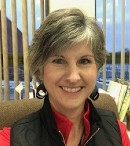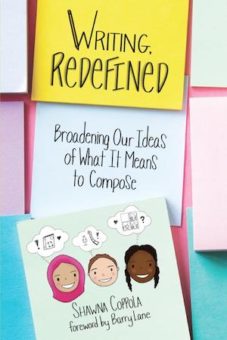Expanding Our Idea of What Writing Should Be
Writing, Redefined: Broadening Our Ideas of What It Means to Compose
By Shawna Coppola
(Stenhouse Publishers, 2020 – Learn more)

I mentioned in a previous review that I read a lot of books, and the teachers I work with probably get tired of hearing “I got a new book!”
For that reason, I try to always read through the lens of the teachers I work with – meaning that I try to always think of which teachers would benefit from this book, which teachers would really want this book, and if this is a book that our teachers would take an interest in.

I’m going to be honest…I had a hard time getting into this book because of that “other teachers” lens I mentioned above. It wasn’t that I didn’t agree with what was being described – the fact that we shouldn’t necessarily keep doing what we’ve always done because we’ve always done it.
It wasn’t that I don’t agree that giving students choice and options in everything isn’t a great idea. It wasn’t that I don’t agree that differentiation means giving students different ways to complete the same assignment.
It was that I kept hearing, “Yeah, but…” in my head, as I imagined conversations with those teacher colleagues I mentioned above.
Are we ready for alternatives to traditional composition?
Coppola does an excellent job of explaining each of her alternative composition suggestions, showing how and why they work well for students, and she addresses several (six to be exact) of those “yeah, buts” with well-thought-out rebuttals (pun intended!).
Most importantly, she gives concrete examples of ways teachers can redefine writing for their students because,
“Redefining writing can offer greater access to the writing club for those individuals who, traditionally, have lacked such access to the club for far too long.”
You may be wondering what is meant by the term “alternative” composition. Shawna explains that “alternative” would be any form of composition that
“…equally privilege(s) alphabetic print along with any other mode of compositions, such as that found in a comic, a zine, or a podcast.”
This book addresses the reality that most classroom writing assignments consist of the traditional compositional modes of essays and book reviews. Coppola offers up three hypotheses to help explain why this may be the case, and then presents the reader with examples of several alternatives to these traditional modes. She also includes QR codes that take you to real-world examples and additional supports.
According to Coppola:
“The only true requirements for redefining writing to include multimodal forms of composition are desire, imagination, and – most importantly – a willingness to take a healthy risk.”
She makes it clear that she is not saying to throw out the way we do everything now and start new! She is asking that we begin to consider that our concept of what “counts” as writing in school is, and has always been, severely limited.
We need to consider what it is that we are really wanting our students to leave our classrooms knowing and being able to do. Maybe – just possibly – the traditional compositional modes aren’t always the best way to get them there!
Coppola leaves us with some final questions:
“Who (or what) is holding us back from ‘redefining’ writing?… Who are we in this for?”
And, finally, this statement of empowerment:
“…the only true limits to doing so are those that we educators have ourselves traditionally placed on classroom writing practices…”
You can read Shawna Coppola’s take on composition in this MiddleWeb post, “Our Students Need a New Definition of Writing,” here.
Pam Hamilton is an intermediate literacy coach in Middlebury, Indiana. She is a trained Reading Recovery teacher and has been in education for over 25 years. She enjoys working alongside teachers as they instill a love of literacy in their students. She also enjoys being wife to Steve and mom to two beautiful daughters, Allie and Peyton.


































